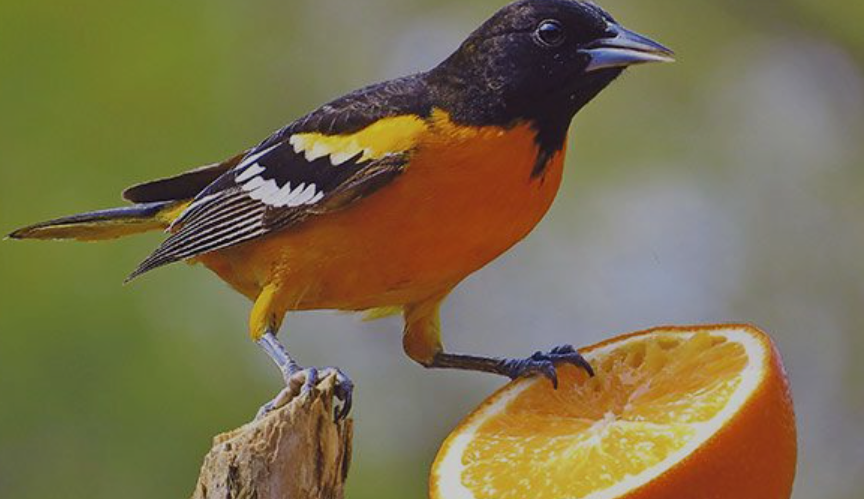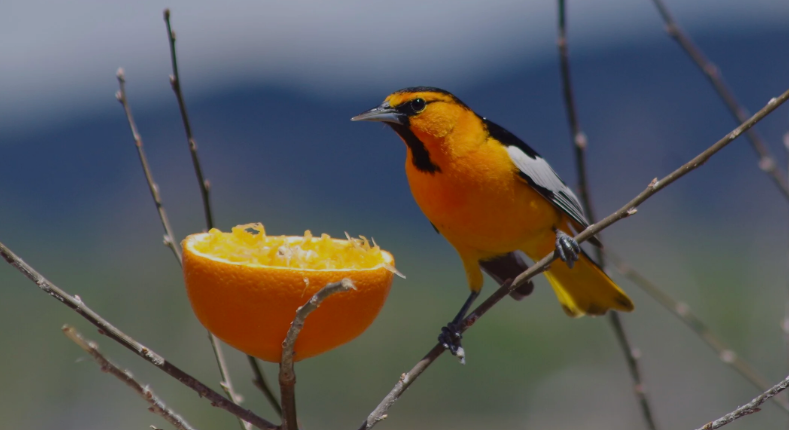
The attraction many avian species have to oranges is both visual and olfactory. The fruit’s vibrant, warm color acts as a natural beacon in a green landscape, easily catching the eye of flying creatures. Coupled with its potent, sweet scent, it signals a high-energy food source, making it irresistible to certain fruit-loving birds, particularly during key times of the year like migration.
The physical act of consuming this fruit varies among different animals. Some use their sharp, pointed beaks to pierce the tough outer skin and probe the soft inner flesh, lapping up the juicy pulp with specialized tongues. Others may simply peck and tear at pre-cut sections, eagerly consuming both the fruit and its sweet juice, which provides a quick energy boost.
This food source is especially valuable during specific times of the year. In early spring, it offers a critical high-energy reward for migrants who have just completed long, exhausting journeys and need to replenish their fat reserves. Later in the summer and into fall, it serves as a reliable supplement for raising young and preparing for the southward migration.
For wildlife enthusiasts, offering slices or halves of this citrus is a common practice to attract certain species to their gardens. The fruit is typically placed on platform feeders or speared onto the ends of branches or specialized feeding spikes. This practice allows for close observation of these animals as they engage in this rewarding behavior.

Birds That Eat Oranges
Baltimore Oriole
One of the most well-known fruit lovers, the Baltimore Oriole is particularly fond of oranges. Backyard bird enthusiasts often put out halved oranges to attract them during spring migration. They use their sharp bills to pierce the fruit and sip the sweet juice, gaining energy for breeding and long flights.
Orchard Oriole
Slightly smaller than its cousin, the orchard oriole also enjoys eating oranges. These birds are attracted to citrus feeders and backyard gardens where fresh fruit is offered. Oranges provide them with hydration and sugars that supplement their insect-rich diet, especially in warmer months.
Bullock’s Oriole
Native to the western United States, the Bullock’s Oriole eagerly feeds on oranges. Like other orioles, it uses a special technique of stabbing the fruit to lap up the juice. They are most often seen eating oranges during migration and nesting season, when energy demands are high.
Scarlet Tanager
This striking red and black songbird has a diet that includes insects and fruit, with oranges being among its favorites. During spring and summer, it may visit feeders where citrus is provided. Oranges supply quick sugars, giving them stamina for long territorial flights.
Northern Mockingbird
Known for its wide-ranging diet, the northern mockingbird also eats oranges. It often pecks at fallen fruit in gardens and orchards, especially during times when insects are scarce. Their adaptability allows them to thrive in both suburban and rural areas where citrus is available.
House Finch
House finches are frequent visitors to feeders offering oranges. They nibble on both the flesh and juice, enjoying the sugars for quick bursts of energy. Their social nature often means that several will gather around fruit feeders at the same time.
Gray Catbird
The gray catbird is a fruit enthusiast and will happily consume orange slices. They are drawn to the bright color and sweet aroma, often returning repeatedly to backyard feeders. Oranges help sustain them during migration and while raising chicks.
Red-Bellied Woodpecker
Although known for eating insects and seeds, the red-bellied woodpecker also has a sweet tooth for fruit, including oranges. It clings to feeders or branches and pecks at the pulp, benefiting from the sugars and moisture.
Brown Thrasher
This bird, with its bold streaks and long tail, has a diverse diet and is fond of fruit like oranges. It usually eats fruit directly from the ground or from feeders. Oranges provide an important energy source, especially during breeding season.
Western Tanager
This bright-colored bird feeds on insects and fruit, but oranges are a seasonal favorite. During migration, they flock to feeders offering citrus, where they consume the juice to replenish lost energy from their long flights.
Summer Tanager
Found in the southern United States, this species enjoys a fruit-heavy diet in addition to insects. Oranges are among the fruits they eagerly consume, especially when placed in backyard feeders, helping them stay hydrated in hot climates.
European Starling
Highly adaptable, the European Starling eats a wide range of foods, including oranges. In gardens and orchards, they are often seen pecking at ripe citrus fruits directly from the trees, sometimes in large flocks.
Blue Jay
Although known for nuts and seeds, blue jays also take advantage of oranges when available. Their strong beaks allow them to tear into the fruit, consuming the pulp and juice for quick energy.
Rose-Breasted Grosbeak
These striking birds migrate long distances and stop at feeders to enjoy fruits such as oranges. They are particularly fond of halved oranges, which provide sugars that fuel their journeys and supplement their diet.
Cedar Waxwing
Cedar waxwings are fruit specialists, often feeding on berries, but they also readily consume oranges. Their attraction to bright, juicy fruits makes oranges a natural choice when other food sources are limited.
American Robin
Though primarily insect-eaters in summer, robins switch to fruit when available. They will eat oranges both in the wild and at feeders, often pecking at slices placed in gardens or yards.
Eastern Bluebird
Known for their insect-heavy diet, eastern bluebirds also consume fruit when offered. Oranges provide a supplementary food source during times when insect populations are low.
Painted Bunting
This colorful bird enjoys a varied diet, and oranges are among the fruits it accepts. The sweet juice gives them an extra burst of energy during breeding season and migration.
Scarlet Macaw
This tropical parrot from Central and South America thrives on a fruit-heavy diet. Oranges are a natural part of its feeding habits, providing hydration and essential vitamins. Their strong beaks easily crack into the fruit, allowing them to consume pulp and juice with ease.
Green Jay
Native to South Texas and Central America, the green jay enjoys a wide diet that includes fruit like oranges. They are curious and opportunistic, often visiting gardens or feeders where citrus is offered.
Yellow-Rumped Warbler
Though small, this bird is highly adaptable and will eat oranges during migration or when insects are scarce. The fruit helps provide much-needed sugar reserves, especially in cooler weather.
Great Kiskadee
Found in South Texas and Central America, the great kiskadee has a varied diet and is known to feed on oranges. It uses its strong bill to tear pieces of fruit, taking advantage of both cultivated orchards and backyard feeders.
Bananaquit
This small, nectar-feeding bird from the tropics also consumes fruit, including oranges. It pierces the skin to sip the juice, benefiting from the sugars in much the same way it does with nectar.
White-Eyed Vireo
Though largely insectivorous, this bird supplements its diet with fruits such as oranges. They often feed on citrus in wild groves or gardens, especially during times when insect populations dip.
Black-Capped Chickadee
These energetic little birds primarily eat insects and seeds but won’t turn down oranges when available. They peck at the fruit in short bursts, taking quick sips of juice before flying off again.
Tufted Titmouse
Closely related to chickadees, tufted titmice also enjoy oranges. They are especially attracted to fruit during late summer and fall when preparing for winter, storing energy in the form of sugary foods.
Golden Oriole
Native to Europe and parts of Asia, this bird is strongly attracted to sweet fruits like oranges. It tears into citrus with its bill, enjoying both the flesh and juice, especially during migration.
Hill Myna
Known for its mimicking ability, the hill myna from South and Southeast Asia is also a fruit enthusiast. Oranges make up part of its natural diet, and the bird consumes them readily in both wild and captive settings.